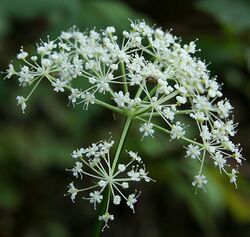Biology:Pimpinella brachycarpa
| Pimpinella brachycarpa | |
|---|---|

| |
| chamnamul flower | |
| Scientific classification | |
| Kingdom: | Plantae |
| Clade: | Tracheophytes |
| Clade: | Angiosperms |
| Clade: | Eudicots |
| Clade: | Asterids |
| Order: | Apiales |
| Family: | Apiaceae |
| Genus: | Pimpinella |
| Species: | P. brachycarpa
|
| Binomial name | |
| Pimpinella brachycarpa (Kom.) Nakai[1]
| |
Spuriopimpinella brachycarpa (Kom.) Kitag. (known formerly as Pimpinella brachycarpa)[2] (common names chamnamul[3][4] and short-fruit pimpinella)[3] is a species in the genus Pimpinella (family Apiaceae). It is a scented plant with saw-toothed, oval leaves, which bears white flowers between June and August, and edible baby leaves.[5]
Culinary use
Like many other species belonging to the parsley family, chamnamul has aromatic leaves and is used as a culinary herb.
Korea
In Korean cuisine, the smooth leaves and crunchy stems of young chamnamul are served fresh or balanced as a spring namul (seasoned herbal vegetable dish). In North Korea, chamnamul-kimchi is a popular dish, known as one of Kim Il-sung's favourite.[6] Recently in South Korea , chamnamul is one of the ingredients that frequently feature in Korean-style western food recipes, such as chamnamul pasta or chamnamul pesto.[7]
Jeonbok-chamnamul-buchimgae (abalone and chamnamul pancake)
References
- ↑ "Pimpinella brachycarpa (Kom.) Nakai". Royal Botanic Gardens, Kew. http://www.theplantlist.org/tpl1.1/record/tro-50005454.
- ↑ Kew Plants of the World Online http://powo.science.kew.org/taxon/urn:lsid:ipni.org:names:849194-1 Retrieved at 11.20 on 4/11/21.
- ↑ 3.0 3.1 English Names for Korean Native Plants. Pocheon: Korea National Arboretum. 2015. pp. 574. ISBN 978-89-97450-98-5. http://www.forest.go.kr/kna/special/download/English_Names_for_Korean_Native_Plants.pdf. Retrieved 6 December 2016.
- ↑ Lee, Soo-Jin; Choi, Ha-Neul; Kang, Min-Jung; Choe, Eunok; Auh, Joong Hyuck; Kim, Jung-In (2013). "Chamnamul [Pimpinella brachycarpa(Kom.) Nakai ameliorates hyperglycemia and improves antioxidant status in mice fed a high-fat, high-sucrose diet"]. Nutrition Research and Practice 7 (6): 446–452. doi:10.4162/nrp.2013.7.6.446. PMID 24353829.
- ↑ "참나물". National Institute of Korean Language. http://krdict.korean.go.kr/eng/dicSearch/SearchView?wordMatchFlag=N&mainSearchWord=%EC%B0%B8%EB%82%98%EB%AC%BC¤tPage=1&sort=W&searchType=W&proverbType=&exaType=&ParaWordNo=78305&nation=eng&nationCode=6.
- ↑ 김, 주원 (29 November 2016). "참나물김치와 황순희" (in ko). Radio Free Asia. http://www.rfa.org/korean/weekly_program/ae40c528c77cac00c758-c228aca8c9c4-c9c4c2e4/co-su-11292016102707.html.
- ↑ 이, 은선 (5 June 2016). "깻잎, 마늘종 넣어 만든 ‘한식 페스토’" (in ko). JoongAng Ilbo. http://www.koreadaily.com/news/read.asp?art_id=4243981.
Wikidata ☰ Q7217371 entry





